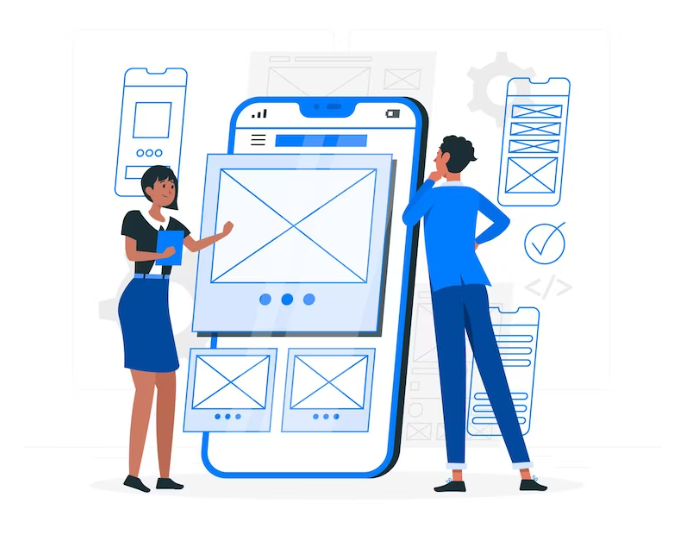Mobile App Development: Choosing Between Native iOS & Android Apps, and Hybrid Apps
In today’s digital age, businesses are increasingly looking for ways to reach their customers more effectively. A mobile app provides an opportunity for businesses to engage with their audience in new ways, and it has become a crucial tool in modern marketing. When it comes to developing a mobile app, businesses have a few options: native iOS and Android apps, and hybrid apps. In this article, we will discuss the advantages and disadvantages of each option, and how to choose the right one for your business needs.
Mobile App Development
Mobile app development is the process of creating software applications that run on mobile devices such as smartphones and tablets. The mobile app industry is rapidly growing, and there are two primary platforms for mobile app development: iOS and Android. iOS is Apple’s operating system for iPhones and iPads, while Android is the operating system for most other smartphones and tablets.
Native iOS and Android Apps
Native apps are developed specifically for a particular operating system, utilizing the tools and programming languages provided by the platform. Native iOS apps are created using Xcode and the Swift or Objective-C programming language, while native Android apps are created using Android Studio and the Java or Kotlin programming language.
Native iOS and Android apps are mobile applications that are specifically designed and built for the iOS and Android operating systems, respectively. Native apps are developed using the platform-specific programming languages, tools, and SDKs provided by Apple and Google, which allow developers to take full advantage of the native features and functionalities of the operating system and the devices they run on.
Native apps provide a better performance, responsiveness, and user experience compared to hybrid or web-based apps, as they can access device-specific hardware and software features such as camera, microphone, GPS, and sensors, and can integrate with other native apps and services seamlessly. They also offer greater flexibility and control over the design, layout, and behavior of the app, and can be optimized for different screen sizes, resolutions, and orientations.
Seamless System Integration for Legacy Systems and Data: Benefits and Best Practices

Advantages of Native iOS and Android Apps
- Performance: Native apps have the advantage of being optimized for the specific platform, resulting in better performance and faster load times.
- User Experience: Native apps have a better user experience as they are built with platform-specific design guidelines in mind. This results in a more intuitive and responsive interface that feels natural to the user.
- Access to Native Features: Native apps have access to all the device’s native features, such as the camera, GPS, and push notifications. This allows for more functionality and a better user experience.
- Offline Functionality: Native apps can store data locally on the device, allowing users to access content and functionality even when they are not connected to the internet. This is particularly useful for apps that rely on real-time data or are used in areas with poor connectivity.
- Security: Native apps can take advantage of the built-in security features of the operating system, such as data encryption and secure boot processes. This helps protect user data and ensures that the app is secure and trustworthy.
- Integration with Other Apps: Native apps can easily integrate with other apps on the device, allowing for a more seamless user experience. For example, a native camera app can be integrated with a social media app to enable users to upload photos directly from the camera app.
- Better Analytics: Native apps can provide more detailed analytics on user behavior and engagement, allowing developers to optimize the app for better performance and user retention.
- Access to Latest Technologies: Native apps can take advantage of the latest technologies and features offered by the platform, such as ARKit and Core ML on iOS, or Android Jetpack and Kotlin on Android. This allows developers to create more innovative and engaging apps that can stand out in a crowded market.
Create a Winning eCommerce Solution
Disadvantages of Native iOS and Android Apps
- Development Time and Cost: Developing native apps for both iOS and Android requires separate development teams, resulting in longer development times and higher costs.
- Maintenance and Updates: As each platform has its codebase, maintenance and updates require separate efforts, adding to the overall cost.
- Approval Process: Submitting an app to the app store can be a lengthy process, with approval times varying between a few days to several weeks.
- Limited Cross-Platform Compatibility: Native apps are built specifically for one platform and cannot be easily ported to other platforms. This can limit the reach of the app and make it harder to maintain and support multiple versions.
- Limited User Base: Native apps are only available to users who have the specific operating system and hardware required to run the app. This can limit the potential user base and make it harder to reach a wider audience.
- App Store Dependencies: Native apps are subject to the rules and regulations of the app store, which can limit the types of content and functionality that can be included in the app. This can be particularly challenging for apps that are used for sensitive or controversial topics.
- Fragmentation: Android is known for its fragmentation, with multiple versions of the operating system and different device screen sizes and resolutions. This can make it harder to ensure that the app works well on all devices and can result in higher development and testing costs.
- Steep Learning Curve: Building native apps requires specialized knowledge and expertise in platform-specific programming languages and tools. This can make it harder for new developers or small teams to create high-quality apps and can result in longer development times and higher costs.
Hybrid Apps
Hybrid apps are developed using web technologies such as HTML, CSS, and JavaScript, and then wrapped in a native container that allows them to be deployed on both iOS and Android platforms. Hybrid apps are built using frameworks such as React Native, Ionic, and Xamarin.
Advantages of Hybrid Apps
- Cost-Effective: As hybrid apps use a single codebase for both platforms, they are more cost-effective than native apps.
- Development Time: Developing a hybrid app takes less time than developing two separate native apps.
- Access to Web Technologies: As hybrid apps are built using web technologies, developers have access to a vast library of existing tools and resources, making development quicker and easier.
- Cross-Platform Compatibility: Hybrid apps can be easily ported to different platforms, including iOS, Android, and web browsers. This can increase the reach of the app and make it easier to maintain and support multiple versions.
- Offline Functionality: Hybrid apps can cache data locally on the device, allowing users to access content and functionality even when they are not connected to the internet. This is particularly useful for apps that rely on real-time data or are used in areas with poor connectivity.
- Easy Updates: Hybrid apps can be updated easily and quickly, as changes made to the codebase are reflected across all platforms simultaneously. This can reduce the time and effort required for maintenance and updates.
- Fast Prototyping: Hybrid apps can be quickly prototyped and tested using web technologies, allowing developers to iterate on the design and functionality of the app rapidly.
- Simplified Development: Hybrid apps use web technologies such as HTML, CSS, and JavaScript, which are easier to learn and use than platform-specific programming languages. This can reduce the learning curve and make it easier for new developers or small teams to create high-quality apps.
Cut Costs with Web Portals and Cloud Solutions

Disadvantages of Hybrid Apps
- Performance: Hybrid apps often have slower performance than native apps due to the overhead of the native container.
- User Experience: Hybrid apps can sometimes feel less intuitive and responsive than native apps due to the differences in design guidelines between platforms.
- Limited Access to Native Features: Hybrid apps have limited access to native features, resulting in a less complete user experience.
- Limited Customization: Hybrid apps may have limited customization options due to their reliance on web technologies, which may limit the ability to create unique and innovative user interfaces or features.
- Security Concerns: Hybrid apps may be more vulnerable to security threats and hacking attempts, as the app is running in a web container that may not have the same level of security as a native app.
- Compatibility Issues: Hybrid apps may have compatibility issues with different versions of operating systems or devices, which can make it harder to ensure that the app works well on all devices.
- Limited Offline Functionality: While hybrid apps can provide some offline functionality, they may not be able to provide the same level of offline access as native apps, which can limit their usefulness in areas with poor connectivity.
- Dependent on Third-Party Tools: Hybrid apps rely on third-party tools and frameworks, which may introduce dependencies and potential issues with licensing or support. This can make it harder to maintain and update the app over time.
Choosing Between Native and Hybrid Apps
When deciding whether to develop a native or hybrid app, there are a few key factors to consider:
- Performance: If performance is critical for your app, such as for gaming or video streaming, a native app may be the best option.
- User Experience: If providing a seamless user experience is important, a native app may be the better option due to its adherence to platform-specific design guidelines.
- Budget: If you have a limited budget, a hybrid app may be the better option as it requires only one codebase, reducing development costs.
- Timeframe: If you need to launch your app quickly, a hybrid app may be developed quicker than two separate native apps.
- Functionality: If your app requires access to native features such as the camera or GPS, a native app may be the best option.
- Target Audience: If your target audience is primarily using one platform, developing a native app for that platform may be more beneficial.
- Maintenance and Updates: If you have a limited budget for maintenance and updates, a hybrid app may be the better option due to the shared codebase.
Conclusion
Choosing between native iOS and Android apps and hybrid apps requires careful consideration of your business needs and priorities. Native apps offer better performance and a better user experience but can be more expensive and time-consuming to develop. Hybrid apps are cost-effective and quicker to develop, but may sacrifice performance and access to native features. Ultimately, the decision should be based on the specific requirements of your business and the needs of your target audience. By understanding the advantages and disadvantages of each option, businesses can make an informed decision and create an app that best serves their customers’ needs. Whether you choose a native app or a hybrid app, mobile app development can be a powerful tool to drive engagement and growth for your business in today’s digital landscape.
If you are looking to develop a high-quality app for your business or organization, don’t hesitate to contact us today! Our team of experienced developers has the expertise to build native iOS and Android apps or hybrid apps that meet your specific needs and requirements. Whether you need a simple app or a complex, multi-functional one, we can help you bring your vision to life. Contact us now to learn more and get started on your app development journey!
